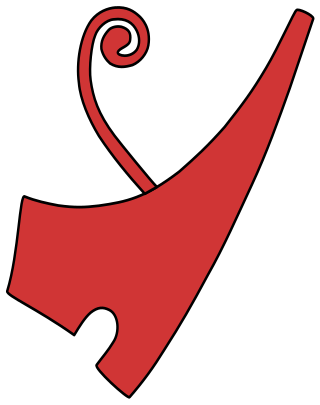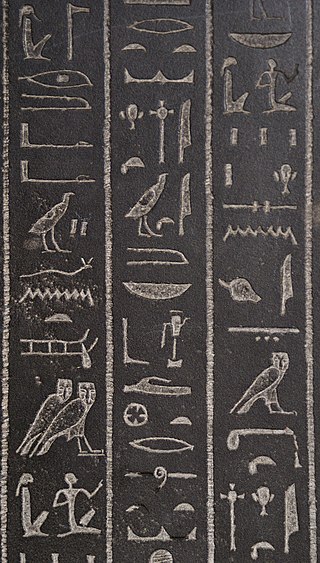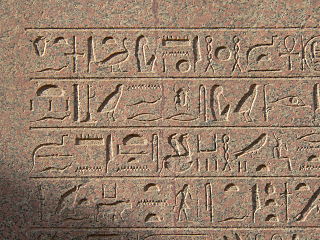
Deshret was the Red Crown of Lower Egypt. When combined with the Hedjet of Upper Egypt, it forms the Pschent, in ancient Egyptian called the sekhemti.

The ancient Egyptian Mast hieroglyph is one of the oldest language hieroglyphs from Ancient Egypt. It is used on a famous label of Pharaoh Den of the First dynasty, but forms part of the location hieroglyph: Emblem of the East.
The ancient Egyptian horizontally-outstretchedArm with powerstick is a hieroglyph with the meaning of "force", or "power of action". As a baton, or macehead. Power is obvious, but the origins may have also had references to magic, or the idea of driving-off bad spirits or omens.

The ancient Egyptian Man-prisoner is one of the oldest hieroglyphs from Ancient Egypt. An iconographic portrayal from predynastic Egypt eventually led to its incorporation into the writing system of the Egyptian language. Not only rebels from towns or districts, but foreigners from battle were being portrayed.
In ancient Egyptian hieroglyphs, the hand symbol represented the phoneme /d/, and was also used as a determinative for actions performed as if with the hands.
The Foreleg of ox hieroglyph of ancient Egypt is an old hieroglyph; it even represented a nighttime constellation. It came to have many uses in ancient Egypt over three millennia.
The Throw stick hieroglyph of ancient Egypt is an old hieroglyph that dates from the Predynastic Period; it is from the assemblage of hieroglyphs used on the ornamental, or ceremonial cosmetic palettes. It is used on the palettes both as a throwing-stick weapon in the animal hunt being portrayed-(the Hunters Palette), as well as on certain palettes, as a determinative referring to a "foreigner", or "foreign territory".
The ancient Egyptian Papyrus stem hieroglyph is one of the oldest language hieroglyphs from Ancient Egypt. The papyrus stalk, was incorporated into designs of columns on buildings, also facades, and is also in the iconographic art portrayed in ancient Egyptian decorated scenes.
The Egyptian hieroglyph for "black" in Gardiner's sign list is numbered I6. Its phonetic value is km. The Wörterbuch der ägyptischen Sprache lists no less than 24 different terms of km indicating 'black' such as black stone, metal, wood, hair, eyes, and animals, and in one instance applied to a person's name.

A quadrat block is a virtual rectangle or square in Egyptian hieroglyphic text.
The pectorals of ancient Egypt were a form of jewelry, often represented as a brooch. These were mostly worn by richer people and the pharaoh.

The Egyptian hieroglyph representing gold, phonetic value nb, is important due to its use in the Horus-of-Gold name, one of the Fivefold Titulary names of the Egyptian pharaoh.
The Illustrated Hieroglyphics Handbook is part of a new genre of books focused on Egyptian hieroglyphs. The book is a graphics based book with four to seven word examples of each Egyptian hieroglyph; the words are graphically explained for each component of the word, and links to the other entries in the book; each hieroglyph is in extreme-artistic-detail and can vary for each hieroglyph, word-to-word. The determinatives ending a word are explained,. Some determinatives are specific to individual trades, i.e. metallurgy, for example and are not in the Gardiner's sign list of Egyptian hieroglyphs.

The ancient Egyptian Hare hieroglyph, Gardiner sign listed no. E34 (𓃹) is a portrayal of the desert hare or Cape hare, Lepus capensis of Egypt, within the Gardiner signs for mammals. The ancients used the name of sekhat for the hare.
The ancient Egyptian b-hieroglyph represents a foot or lower leg.
The ancient Egyptian Face hieroglyph, Gardiner sign listed no. D2 is a portrayal of the human face, frontal view.

The Egyptian hieroglyph ndj (nḏ) has the shape of a cross. It presumably depicts some type of tool such as a mill. It is often written alongside the nu "pot" hieroglyph (W24). It is used as an ideogram or determinative in the context of "grains", "grinding stone", "grind", "to rub out".

The ancient Egyptian Arms-in-embrace hieroglyph, Gardiner sign listed no. D32 is a portrayal of the embracing human arms. The hieroglyph is in the large Gardiner sign list category of Parts of the Human Body.

In Budge's compendium dictionary, there are fifteen entries with nedjem, and related words. Six of them are a doubling of the word, nedjemnedjem related to passion, concubines, etc.

The ancient Egyptian Bread bun hieroglyph is Gardiner sign listed no. X1 for the side view of a bread bun. It is also the simple shape of a semicircle. The hieroglyph is listed under the Gardiner category of loaves and cakes.















